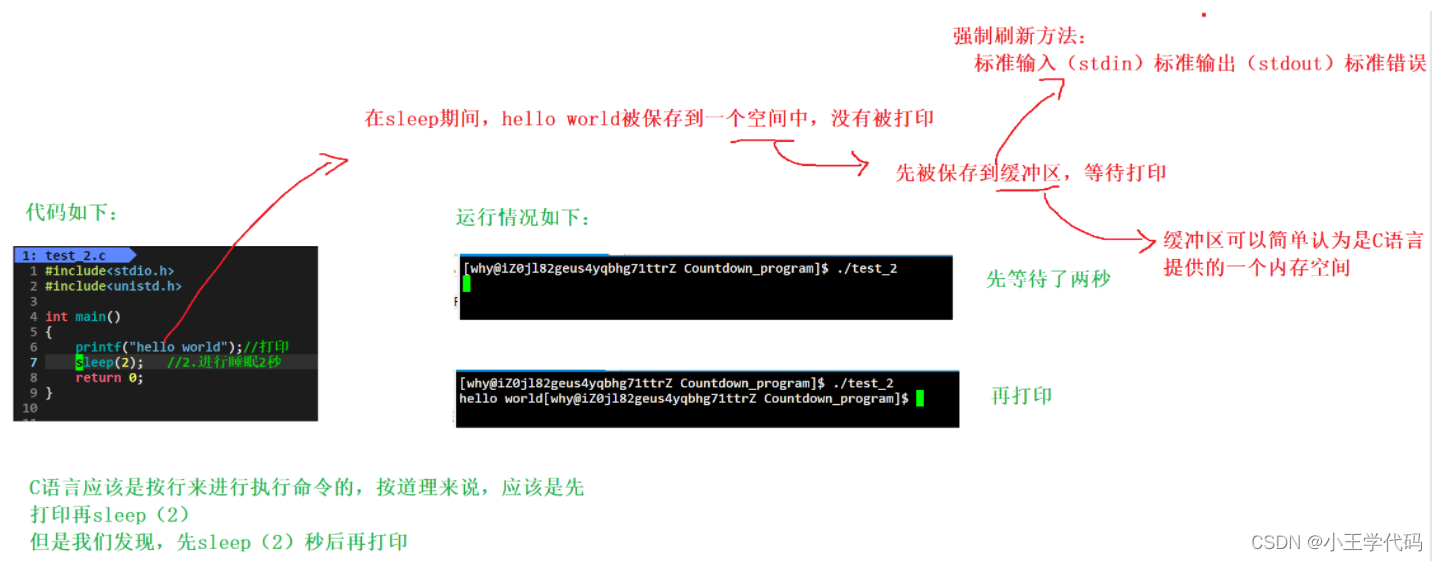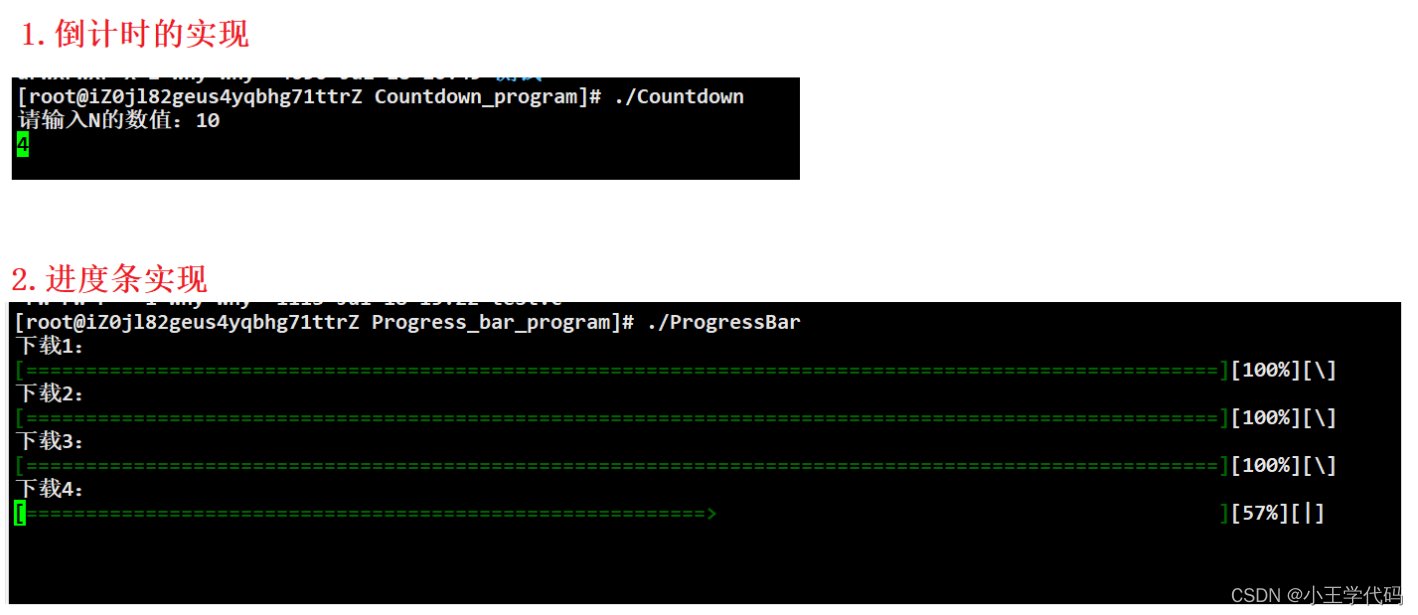Linux小程序:倒计时和进度条
Linux小程序
在Linux中我们实现两个小程序来体会r和n的区别,以及缓冲区是什么?
前言
回车和换行的区别
对于 r 和 n 的理解:
- n 表示换行且回到下一行的最开始的位置
- r 表示的是回车,即将光标回到当前行最开始的位置
在C语言中,我们单单使用“n”就可以实现换行回车,但是”r“只能表示回车
//在定义中n表示的是换行符号,只是在语言实现中,包含了自动回车这一功能,最后导致,n为换行回车
#include<stdio.h>
void Func1()
{
printf("hello worldn");
printf("换行+回车n"); //hello world
return; //换行+回车
}
void Func2()
{
printf("123456r");
printf("654n"); //测试结果为654456
return;
}
int main()
{
printf("测试换行n");
Func1();
printf("测试回车n");
Func2();
return 0;
}
缓冲区
Linux缓冲区是指在内存中开辟的一块区域,用于存储输入输出数据的临时存储区域。当应用程序向文件或设备进行读写操作时,数据会先被存储到缓冲区中,然后再由缓冲区将数据写入磁盘或设备中。缓冲区的作用是提高数据读写的效率,减少磁盘或设备的访问次数,从而提高系统的性能。在Linux系统中,缓冲区的大小可以通过修改内核参数来进行调整。
我们来看看缓冲区的体现

认识fflush函数
fflush(stdin)是清空输入缓存的函数,在输入字符之前调用它可以清除之前未读取的字符。
fflush(stdout)是刷新输出缓冲区的函数,它可以强制将缓冲区中的输出立即发送到输出设备(通常是显示器)。它对应的头文件是<stdio.h>
#include<stdio.h>
#include<unistd.h> //sleep的头文件
int main()
{
printf("hello world!")
fflush(stdout); //刷新缓冲区
sleep(2);
return 0;
}
总结
- n 自带刷新缓冲区的功能
- fflush(stdout)可以强制刷新输出缓冲区的函数
小程序的实现
我们学习了上文中的换行和回车,以及缓冲区的概念,以此尝试在Linux中尝试做两个小程序,倒计时和进度条程序的实现。
倒计时程序
结合换行和回车,以及缓冲区的概念,我们可以实现倒计时
# include<stdio.h>
# include<unistd.h>
void Fun1(int n)
{
//实现倒计时的函数
int i=n;
for(; i >= 0 ; i-- )
{
printf("%-5dr",i);
fflush(stdout);
sleep(1);
}
}
int main()
{
//实现倒计时,我们测试过缓冲区和换行回车
//倒计时的实现应该是使用 r 回车符号,不断变更数值
int n=0;
printf("请输入N的数值:");
scanf("%d",&n);// 实现任意倒计时
//实现函数主体
Fun1(n);
return 0;
}
进度条程序
进度条是指通过展示下载的过程(进度)以及百分比还有加载光标,来模拟进度条。
Progressbar.h
进度条头文件,我们在里面声明函数,宏定义变量,导入头文件。
//下面是Progressbar.h文件内容
# pragma once
#include<stdio.h>
#include<unistd.h>
//进度条的头文件,进行设置宏定义
#define Num 102
#define Top 100
#define Body '='
#define Right '>'
//声明函数
extern void progressbar(int speed);//实现
extern void initbar(); //初始化
Progressbar.c
//实现进度条程序的主要文件
#include<stdio.h>
#include "ProgressBar.h"
#include<string.h>
#include<unistd.h>
//方案二:
const char* lable="\|/-";
char bar[Num];
#define GREEN "33[0;32;32m" //这是改变打印的颜色语句
#define NONE "33[m"
void progressbar(int rate) //rate表示的是当前的进下载进度 0-100区间的范围
{
//rate 表示的是当前下载进度
if(rate<0||rate>100 ) return ;
int len=strlen(lable);
printf(GREEN"[%-100s]"NONE"[%d%%][%c]r",bar,rate,lable[rate%len]);
fflush(stdout); //使用fflush强制刷新输出缓冲区
bar[rate++]=Body;
if(rate<100) bar[rate]=Right; //只要没有超过100 就加上Right
}
void initbar()
{
memset(bar,'',sizeof(bar));
}
//下面是第一种方法,直接调用progressbar(加载速度) 传参为speed 即文件下载速度
//方案一:
//void progressbar(int speed)
//{
// //实现进度条代码
// char bar[Num];
// //初始化bar
// memset(bar, '', sizeof(bar));
//
// //使用while循环实现
// int len = strlen(lable);
// int count = 0;
// while (count <= 100)
// {
// //进行打印
// printf("[%-100s][%d%%][%c]r", bar, count, lable[count % len]);
// fflush(stdout); //没有n,就无法刷新,只能手动刷新,使用fflush,显示器默认的是行刷新
// bar[count++] = Body;
// if (count < 100) bar[count] = Right;
// usleep(speed);
// }
// printf("n");
//}
test.c
这是主要文件,从该文件传参实现文件的运行
#include<stdio.h>
#include"ProgressBar.h"
typedef void (*callback_t)(int);// 函数指针类型
void downLoad(callback_t cb) //使用函数指针来调用
{
//callbak_t 实际上就是表示一个参数为int的函数指针,那么cb表示这个函数名
int total =1000; //下载的总容量
int curr=0; //当前下载的容量
while(curr<=total)
{
usleep(50000); //表示模拟下载花费的时间
int rate=curr*100/total; //更新进度
cb(rate);//将rate参数传递给cb函数(形参)
curr+=10;//表示一次循环下载了一部分
}
printf("n");
}
int main()
{
printf("下载1:n");
downLoad(progressbar);
initbar(); //进行对于bar初始化
printf("下载2:n");
downLoad(progressbar);
initbar(); //下载一次就要进行初始化
printf("下载3:n");
downLoad(progressbar);
initbar();
printf("下载4:n");
downLoad(progressbar);
initbar();
return 0;
}
//方案一: 手动控制每一次加载usleep的时间
//int main()
//{
// //实现进度条的主程序
// printf("第一次加载:n");
//
// progressbar(100000);
//
// return 0;
//}

总结
- n和r我们都进行了解释和演示,对于缓冲区的概念图文解释,认识到了两种方式来强制刷新缓冲区。
- 标准输入(stdin)标准输出(stdout)标准错误 ,我们认识到了fflush函数来强制刷新
- n 实际上是执行换行+回车操作的,也有刷新缓冲区的作业
- 我们实现了两个Linux上的小程序,倒计时以及进度条。
